Also called magnesium sulfate, Epsom salt is often favored as a good additive for tomatoes. This article therefore seeks to critically examine this assertion by considering the biochemical interactions between Epsom salt and tomato plants. The review will also look at the key nutrients that are necessary for optimum growth of tomatoes with specific emphasis on the roles played by sulfur and magnesium. Additional areas for assessment in this write-up include various application techniques and their efficacy as well as misconceptions or caveats related to the use of Epsom salt in agriculture. Thence, by providing empirical helps in concluding whether or not tomato plants benefit from Epsom salts, it is hoped that readers can gain enough knowledge to make well-informed choices regarding their cultivation practices.
What Are the Benefits of Using Epsom Salt in the Garden?
There are several garden benefits of Epsom salt due to its magnesium sulfate content. Magnesium is important in photosynthesis where plants use it in chlorophyll synthesis. Sulfur on the other hand, even though required in smaller amounts is needed for synthesis of amino acids and enzymes. By applying Epsom salt to soil or as a foliar spray, it can help rectify magnesium deficiency thus improving the overall health of plants hence their productivity. More chlorophyll formation means more green leaves and vigorous growth. Also, adding sulfur aids nutrient assimilation and improves resistance to diseases therefore making the use of Epsom salt an important addition towards promoting healthy crop growth and high yields.
How Does Epsom Salt Affect Tomato Plant Growth?
Epsom salt affects tomato plant growth by providing them with magnesium and sulfur, essential nutrients for their physiological processes. Magnesium plays a crucial role in chlorophyll synthesis required for efficient photosynthesis. High levels of chlorophyll facilitate better capture energy from sunlight leading to greener leaves and more robust growth. In tomatoes, the standard recommended amount for treating magnesium deficiencies is approximately 1 tablespoonful per gallon of water through foliar sprays or soil drenching.
Although sulfur is required in lesser amounts, it is necessary for synthesizing amino acids such as methionine, cysteine, proteins, and enzymes that support efficient nutrient uptake/utilization by plants. Another reason we need to apply Epsom salt is that it enhances plants’ resistance against diseases by strengthening cellular structures while enhancing metabolic pathways.
Does Epsom Salt Provide Essential Nutrients?
Yes! Specifically; it provides essential nutrients which include magnesium (Mg) and sulfur (S), vital minerals involved in various physiological processes within the plants’ bodies. Chlorophyll production requires sufficient Mg since its central atom is made up of this element thereby allowing abundant photosynthesis resulting into greening of the leaves and faster growth. Reputable horticultural websites advise that one should mix 1 tablespoon of Epsom salt with a gallon of water for use in foliar sprays or soil drenches, when magnesium deficiency is apparent.
Although required in lesser amounts, sulfur plays a key role in the synthesis of essential amino acids and proteins. Therefore, it contributes to overall plant health and development through enzyme functioning and nutrient uptake. These two elements work together to enhance plant metabolic processes and disease resistance, making Epsom salt an important addition to fertilization programs.
- Magnesium (Mg) Content: Approximately 9.8% by weight.
- Sulfur (S) Content: Approximately 13% by weight.
- Optimal Dosage: If applied in the correct amounts, 1 tablespoon per gallon of water is sufficient for both foliar sprays and soil drenches.
How to Apply Epsom Salt to Tomato Plants?
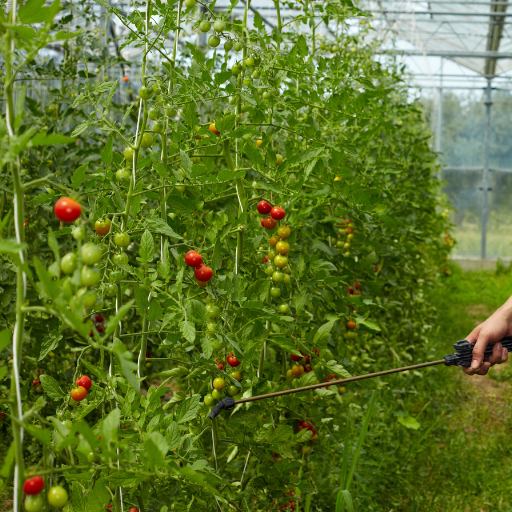
In order to apply Epsom salt on tomato plants, you can make both foliar sprays and soil drenches for efficient nutrient uptake. For the foliar applications dissolve 1 table spoon of Epsom salt into a gallon of water and spray directly onto the leaves. This method quickly takes magnesium and sulfur up through the leaves. For soil drenching, mix the same concentration, that is 1 tablespoon per gallon of water, and put around the base of the plant. This encourages root absorption thus providing a slow but steady supply of necessary nutrients. It is advisable to regularly treat the crop every two weeks during its growth in order to avoid cases of nutrient deficiency in plants foster robust development as well as improve fruit production.
How to Apply Epsom Salt in Your Garden
- Spraying: The way this happens is by dissolving one tablespoon full of epsom salt in one gallon of water then applying it directly to plant’s leaves through spraying. On top of that, leaf spraying results in rapid absorption of magnesium and sulphur via foliage leading to timely correction for these deficiencies.
- Drenching: Mix one tablespoon of Epsom salts with one gallon of water and pour it all over the base area around where your plant stands. In this connection, roots absorb nutrients, making sure that there are enough supplies for metabolic processes by plants, such as magnesium and sulfur.
- Soil Amendment: When preparing gardens or transplant beds, some individuals use Epsom salts as a soil amendment. A cupful od epson salt should be mixed with 100 square feet soil so as to increase its fertility thereby producing healthier crops.
- Pre-planting Treatment: Seedlings should be soaked in one tablespoonful epsom salt solution per each gallon before being transplanted. Doing this will stimulate strong root system thus allowing seedling establishment.
Amounts Required Per Plant
The amount depends on various factors such as the plant type and stage of growth, for general use, especially with vegetables and flowers, an estimate is to apply 1 tablespoon of Epsom salt per foot high that crops are. For instance, if a plant is 2 feet tall, mix 2 tablespoons of Epsom salt with water and apply. In case of tomatoes, it is recommended to use one tablespoonful of Epson salts for one foot high once every month while plants are developing. Regarding roses, during spring and fall seasons include half cupfuls of epsom salts into the soil thereby improving blooms and promoting healthy growth. To avoid excess salt concentration in the ground always dilute epsom salt in water before applying it either through drenching or spraying.
When Should You Use Epsom Salt During the Growing Season?
- Pre-Planting: Prior to planting transplants soak them in a gallon-water solution containing one tablespoonful Epsom salts to promote strong root development.
- Early Growth: Apply epsom salts to the soil at beginning (one tbsp per ft height) for initial plant production particularly for heavy feeders like tomatoes or peppers.
- The Mid-Season: The halfway point in the growing season is usually when flowers begin to emerge, and it is the best time to apply Epsom salt as a solution to maintain magnesium levels. Epsom salt promotes chlorophyll production and improves general plant health. Use 1 tablespoon per foot of plant height as a soil drench or 2 tablespoons per gallon of water as a foliar spray.
- The End of Season: For roses and similar plants, give them a dose of Epsom salt early in the fall to prepare for their next blooming period. Apply ½ cup of Epsom salt for each plant.
Can Epsom Salt Help Prevent Problems Like Blossom End Rot?
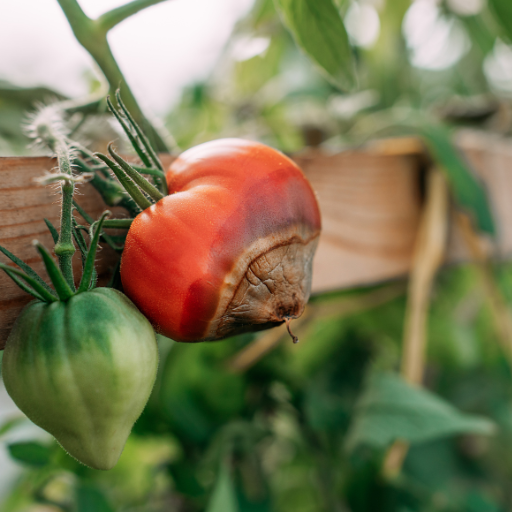
Blossom-end rot mainly results from a shortage of calcium in the plant thus causing dark, sunken spots on fruit. Although magnesium sulfate known as Epsom salt can boost the level of soil magnesium, it does not address the root cause of blossom end rot that is low calcium levels. In order to prevent blossom-end-rot effectively, there should be constant and adequate supply of calcium to the plants, consistent soil moisture, and avoiding watering stress. Although it may potentially improve overall health of other parts of the plant and promote growth processes in general; Epsom salt is not an immediate answer for preventing blossom-end-rot.
Role of Magnesium and Calciumin Preventing Plant Diseases
Magnesium and calcium play critical roles in protecting plants against diseases by promoting healthy cell function and structure. This is because intracellular blockage could hinder full functions of these cells even leading to collapse or death. Magnesium acts as major component in chlorophyll which is essential for photosynthesis hence it supports general vigor for the whole plant including disease resistance. Additionally it activates many important enzyme systems needed for growth. On the other hand, Calcium guarantees stability and structure to cell walls, thereby providing defense against pathogens invading into the cells. It also enhances root development with tip elongation necessary for nutrient absorption as well as disease prevention. By strengthening cellular structures and fortifying metabolic processes higher amounts of both nutrients can enhance plant resilience against diseases.
How to Identify Blossom End Rot in Tomato Plants
Of all tomato crops, one can identify blossom end rot through various distinctive symptoms only affecting them primarily . Initially, there appears a small water-soaked lesion at the fruit’s distal end near the point where it is attached to the pedicel, which progressively enlarges into a blackened hollow area referred to as a spot on mature tomatoes. The affected region may expand up to one third part of skin’s surface while also becoming leathery often times Physiologically, this disorder is attributed to a deficiency in calcium, caused by irregular water supply or poor absorption due to high salt concentration in the soil.
Technically, soil calcium levels should be monitored to ensure they remain within the range of 2000 to 4000 ppm. The ideal pH level of calcium absorption ranges from 6.2 through 6.8. Besides, it is also necessary to maintain uniform moisture conditions in the moistened soil and avoid excessive nitrogen fertilization and mulching ultimately helping to reduce this kind of risk. To prevent blossom‑end-rot, one should use regular testing for Calcium concentration and adjustment of Ph-levels if necessary.
Steps to Mitigate Blossom End Rot with Epsom Salt
- Preparation: Dissolve one tablespoonful of Epsom salt in a gallon of water.Epsom salt contains magnesium and sulphur which are required for overall plant welfare.
- Application: Apply this solution around each tomato plant at the base where it touches the ground every two weeks throughout the growing season. Foliar feeding may not be effective.
- Consistent Watering: Keep soil consistently moist but not waterlogged. Regular watering ensures proper calcium intake, which is vital for preventing blossom-end rot disease.
- Soil Testing: Regularly conduct soil tests monitoring magnesium levels within their optimal range. This will enable one adjust use of Epsom salts based on these tests thus avoiding any imbalances in nutrients.
- Supplementation: If calcium deficiency is found, you may use lime to increase calcium in your soil or use a calcium spray.
Is a Soil Test Necessary Before Using Epsom Salt?
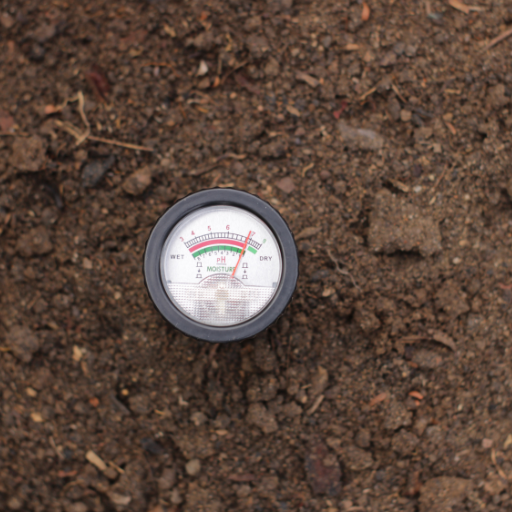
It is highly recommended that a soil test be done before putting Epsom salt into use. First and foremost, Epsom salt provides magnesium and sulphur which are beneficial to plant health. However, using it without first knowing the current nutrient levels in the soil may cause disparities. The information from a soil test will show the existing levels of magnesium, calcium and pH thus enabling corrective adjustments. This information makes sure that Epsom salt is needed and used correctly hence minimizing excessive magnesium which can interfere with calcium absorption, thereby affecting general nutrient uptake.
Steps on Conducting a Soil Test
- Collect Soil Samples: Take soil samples from different parts of your garden for a representative sample. Use a clean trowel or soil probe to collect soil from the root zone about 6-8 inches deep. Combine these samples in a clean bucket.
- Prepare Samples: Mix the soils properly to ensure uniformity. Remove any litter, such as stones, leaves, or roots. The sample should be left outside for drying but not under an artificial heat source.
- Select Testing Method: Home testing kits or professional laboratory analysis are alternatives. Home kits suffice for basic nutrient and pH levels, whereas details on magnesium, calcium, and pH, among others, would only be available through laboratory tests.
- Conduct the Test: Follow instructions of home kit carefully which may involve mixing soil with some chemical solution then comparing color change to standard chart provided; if laboratory analysis type; put dried soil into supplied container as directed then send it over there.
- Interpret Results: When you receive your results, check what has been reported on the nutrients and pH levels of your soil. Pay close attention to magnesium, calcium, and soil pH levels, especially. This helps you know whether you need to add Epsom salt or other supplements to your soil.
Understanding Vegetable Garden Soil Test Results
- Soil pH: The ideal pH range for vegetable gardens is between 6.0 and 7.0. If the soil is too acidic (below 6.0), lime can be added to raise its pH. On the other hand, if it is too alkaline (above 7.0), sulphur or organic matter will help reduce it.
- Nitrogen (N): Nitrogen is required for leafy growth – levels should be optimized according to plant needs often requiring regular supplementation; on the contrary, an overdose might result in lush foliage with less fruits or vegetables.
- Phosphorus (P): An essential nutrient for root development and flowering, phosphorus should be balanced at all times; deficiency may lead to stunted plant growth and reduced flowers while excess interference with uptake of other nutrients.
- Potassium (K): Adequate potassium levels promote overall plant health and resistance to diseases, ensuring vigorous growth and quality produce; low potassium may cause weak plants, leading to poor yields.
- Magnesium and Calcium: Magnesium is necessary for chlorophyll production while calcium is needed for cell wall structure; both elements are vital in promoting healthy plant growth because deficiencies can lead to yellowing leaves (magnesium) or blossom end rot (calcium).
Adjustments after Soil Test Results
- Evaluate Soil Magnesium Levels: If the soil test shows a magnesium shortage typically measured by readings below 100 ppm or a Mg saturation below 10%, Epsom salt could be a suitable fixative action.
- Application Rates: According to the major horticultural sources, the recommended application rate of Epsom salt is about a tablespoon for each foot tall mature plant or one tablespoon per 12 inches of garden bed soil surface. This should be done every six weeks throughout the growing season to maintain magnesium at the optimum level.
- Method of Application: There are two main ways that Epsom salts can be applied:
- Soil Application: Before planting, mix Epsom salt with soil or spread it directly on the soil surface around established plants, and water thoroughly to facilitate absorption.
- Foliar Spray: Dissolve one tablespoonful of Epsom salt in a gallon of water to make a foliar spray solution. Use this solution on leaves by using either a hand sprayer or a plant mister to improve its ability to penetrate plant tissue more quickly into the cells through stomata.
- Monitoring and Adjustments: It remains necessary then to monitor plant response and soil magnesium levels regularly. If symptoms persist, it may require several applications; otherwise, excessive use could lead to dilution through more watering or other nutrients balancing irrigation amendments.
Are There Risks or Downsides to Using Epsom Salt for Tomatoes?
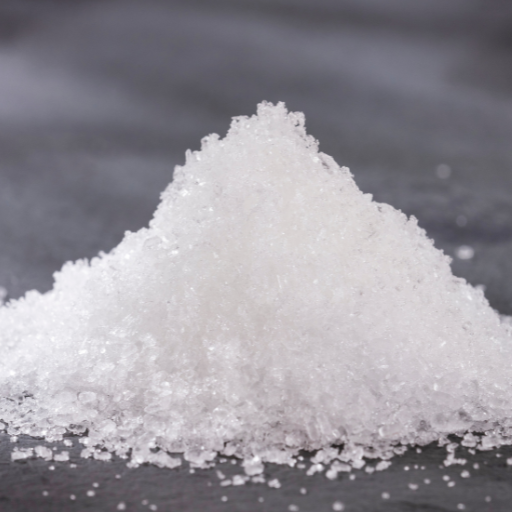
Although Epsom salt can correct magnesium deficiencies in tomatoes, it is important to consider risks and disadvantages. The excessive use of Epsom salt leads to imbalances of the soil nutrients particularly affecting calcium uptake necessary for preventing blossom end rot among tomatoes. These high levels of magnesium also interfere with other essential nutrients like potassium and nitrogen which may result in their deficiency. Moreover, repeated application of Epsom salt could lead to increased salinity levels in the soil which are harmful for plants and negatively influence their productivity. Therefore, it is important for farmers always to do a soil test and continually check the nutrient status to not over-supply and ensure proper soil fertility.
Can Overuse of Magnesium Sulfate Harm Plants?
Yes, overuse or misuse of magnesium sulfate commonly referred as Epsom salts can harm plants by causing unbalance in the nutrient values found inside soils. Too much presence of magnesium sulphate can cause interferences between major elements such as; calcium, potassium and nitrogen. It is advised that we should keep our cation exchange capacity (CEC) at 1.2-3% Mg for optimal growth rate within our agricultural practices subjecting anything above this range will result into competitive inhibition where roots of a plant absorbs magnesium selectively than any other vital nutrient.
High levels of magnesium sulfate can exacerbate issues like blossom end rot in tomatoes due to impaired calcium absorption. Data indicate that soil calcium levels below 1,000 ppm, when combined with excessive magnesium, significantly increase the risk of blossom end rot. Also, excess magnesium sulfate application enhances the salinity level in the soil, thereby reducing water uptake efficiency, leading to possible plant stress or even toxicity.
Therefore, meticulous monitoring of soil nutrient levels through regular soil tests is paramount. Maintaining an ideal magnesium-to-calcium ratio of 1:5 would help us maintain a balanced nutrient availability should irrigation practices need adjustment or soil amendments be required if abnormal levels are detected.
Is Epsom Salt Good for All Vegetable Gardens?
Does Epsom salt work on all vegetable gardens? The answer is yes but no. This is because it may be beneficial in magnesium-deficient soils, which are detrimental to some plants like tomatoes, peppers, and roses. Conversely, where there is already sufficient magnesium content in the soil, Epsom salt will have little impact since it will only increase nutrient imbalances.
According to the top agronomic sources, an Epsom salt application rate of 1-2 tablespoons per gallon of water, applied once a month, is sufficient for foliar feeding or soil drenching in magnesium-deficient plants. Technical parameters indicate that soil magnesium levels should ideally be maintained within the 1.2% to 3% range of the soil’s cation exchange capacity (CEC). Soil tests should help determine whether or not additional amounts of Epsom salt must be added if its levels are within this range.
Furthermore, excessive magnesium can impair the uptake of calcium and potassium, leading to deficiencies and issues such as blossom end rot in tomatoes. Therefore, before applying Epsom salts, farmers must conduct soil tests to establish the existing nutrient status and adjust their amendment practices accordingly. This ensures that nutrients are balanced appropriately, maintaining optimal plant health and productivity with a desirable ratio of Mg:Ca about 1:5.
Practical Tips for Gardeners Using Epsom Salt
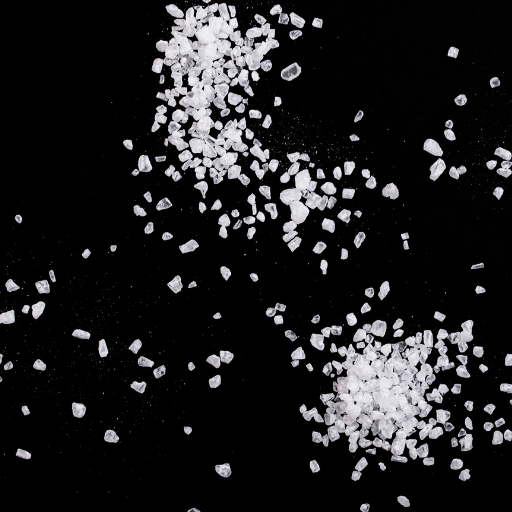
For a vegetable garden, one should commence by soil testing to find out if there is a lack of enough magnesium using Epsom salt. Only apply Epsom salt in cases where deficiency symptoms are observed or when soil magnesium levels are low. For soil drenches, add 1-2 tablespoons of Epsom salts in a gallon of water and pour at the base of plants. Regarding foliar application, mist leaves every two weeks with the same proportion in a small spray bottle. It is also crucial to watch for over-application symptoms like yellowing or leaf curling that may signal nutrient imbalances in your plants. Further, always strive for a middle course by mixing organic fertilizers with Epsom salt to enhance the soil’s overall health.
How to Incorporate Epsom Salt into Your Regular Gardening Routine
To integrate Epsom salt into your regular gardening routine, take a systematic approach that will enable you to monitor soil condition and the plants’ wellbeing. Start by doing a comprehensive soil test for magnesium deficiency or imbalance. If the soil lacks some magnesium, it should be introduced gradually and carefully in small quantities. For general application purposes one to two tablespoons of Epsom salt should be mixed with water gallon and used for drenching soils at plant base every four to six weeks or so. The same mixture can also be sprayed on foliage per fortnight when using foliar spray.
Technical parameters include magnesium content of soil, sensitivity of specific types of plants cultivated and prevailing nutrient profile in that field. Magnesium levels should lie within 1.2% – 3% of CEC (cation exchange capacity) of the soil hence an optimal Mg/Ca ratio is meant to keep nutrients balanced at around 1:5. By incorporating Epsom salt prudently and observing how plants respond, gardeners can improve their soils’ health conditions and promote massive growth.
Common Mistakes to Avoid When Using Epsom Salt
Overuse is one common mistake that can result in mineral imbalances and negatively affect your crops. Excessive amounts of magnesium hinder the ability of calcium and potassium which are essential in nutrient uptake even when these minerals are sufficiently present in the ground. Always stick to recommended doses therefore so that you can frequently check up on whether your crops are healthy or not.
The other error is applying it without testing first what kind of dirt one has on his field before adding Epsom salt; this could be unnecessary supplementation regarding magnesium already available from natural sources or may prove harmful instead.. Soil tests give such vital information like levels of magnesium ions among other elements making informed choices for improvement easier by adding fertilizers including this compound. Maintaining soil magnesium within the 1.2% to 3%, as per the cation exchange capacity (CEC) determines proper nutrient balance.
Moreover, failure to consider plant species’ tolerances may result in negative consequences. For instance, while some plants such as tomatoes and roses need more magnesium, others may not require it. Follow your plants’ specific requirements to avoid problems or mistakes where they are not needed at all. These common pitfalls enable planters to use Epsom salt proficiently and improve plant growth and soil health.
Long-term Effects of Epsom Salt on Soil and Plant Health
Over time, repeated use of Epsom salt – magnesium sulfate- can affect soil health and crop production systems differently. Continuous application increases the amount of magnesium found in soils, altering their physical structure and characteristics. High levels of this element cause compaction leading to poor aeration and infiltration as well as a change in CECs of these soils. Consequently, other necessary nutrients like calcium or potassium have their availability impaired because free ionised form of this metal competes with them for absorption sites located near clay minerals.
From a technical standpoint, one way to avoid imbalance is to ensure that soil Mg stays within 1.2% – 3% range of CEC when considering appropriate soil concentration for long term use. Taking regular samples from such regions is vital for checking this out hence adjusting subsequent fertilizer applications accordingly.
Again, different species respond differently in terms of their health status due to this factor alone. This can be observed with crops like tomatoes, peppers or rose that show higher yields if sufficient supply is availed among them (magnesium). Nonetheless too much Mg may lead to nutrient antagonism where macronutrients become less available resulting into chlorosis or stunting observed on susceptible cultivars thereby showing symptoms associated with low iron conductivity through veins between leaves called interveinal chlorosis shade or even fast growth inhibition.
In conclusion, when used thoughtfully, Epsom salt can be advantageous in some circumstances; however, this requires vigilance in soil monitoring and application strategies tuned to avoid possible long-term undesirable effects. Regular soil testing and strict adherence to technical recommendations can help maintain good soil health and enhance optimum crop production.
Frequently Asked Questions (FAQs)
Q: Is Epsom salt actually good for tomato plants?
A: Yes, Epsom salt is beneficial for tomato plants as it provides magnesium, which is a crucial micronutrient for the production of chlorophyll, aiding in photosynthesis.
Q: How should I use Epsom salt for plants when growing tomatoes?
A: You can use Epsom salt directly on the soil by dissolving one tablespoon in a gallon of water and applying it to the base of the plant. It can also be added to the potting mix during seed starting or sprinkled around the plants.
Q: What are the benefits of using Epsom salt for plants like magnesium and sulfur need?
A: Epsom salts are good for providing essential micronutrients such as magnesium and sulfur. These nutrients support the production and absorption of other nutrients, improving the overall health and production of the plant.
Q: Can I use too much magnesium or sulfur from Epsom salt on my plants?
A: It is possible to add too much Epsom salt, which can lead to nutrient imbalances. Moderation is key to ensuring that your plants receive the right amount of magnesium without causing harm.
Q: How do you know if your soil is deficient in magnesium?
A: If plants look pale or yellow, it could indicate a magnesium deficiency. Soil testing can confirm if your soil lacks this essential nutrient.
Q: Is Epsom salt suitable for new seedlings and tomato seeds?
A: Yes, Epsom salt can be beneficial for new seedlings and tomato seeds, as it helps in germination and provides essential nutrients for healthy growth.
Q: What do successful tomato plants look like when using Epsom salt?
A: Successful tomato plants using Epsom salt typically have vibrant green leaves, sturdy stems, and produce bountiful fruit due to the adequate absorption of nutrients.
Q: Can Epsom salt help with pest control for tomatoes?
A: While Epsom salt is not directly a pest control, healthier plants are generally more resilient to pests. Ensuring your plants have the right nutrients may help them resist pest infestations.
Q: How often should I apply Epsom salt to my tomato plants?
A: You can apply Epsom salt every 3-4 weeks during the growing season. Dissolve one tablespoon in a gallon of water and apply it to the base of the plant for optimal results.
Q: Can Epsom salt be used for other plants, such as pepper plants?
A: Yes, Epsom salt can be beneficial for other garden plants, including pepper plants, as it provides essential nutrients that facilitate healthy growth and development.






